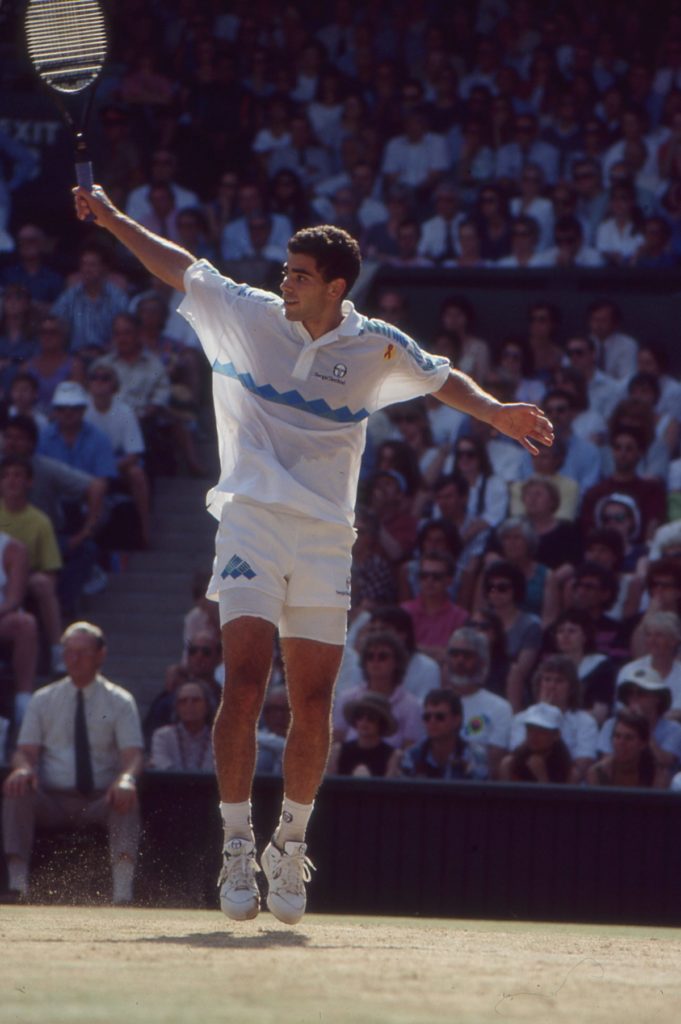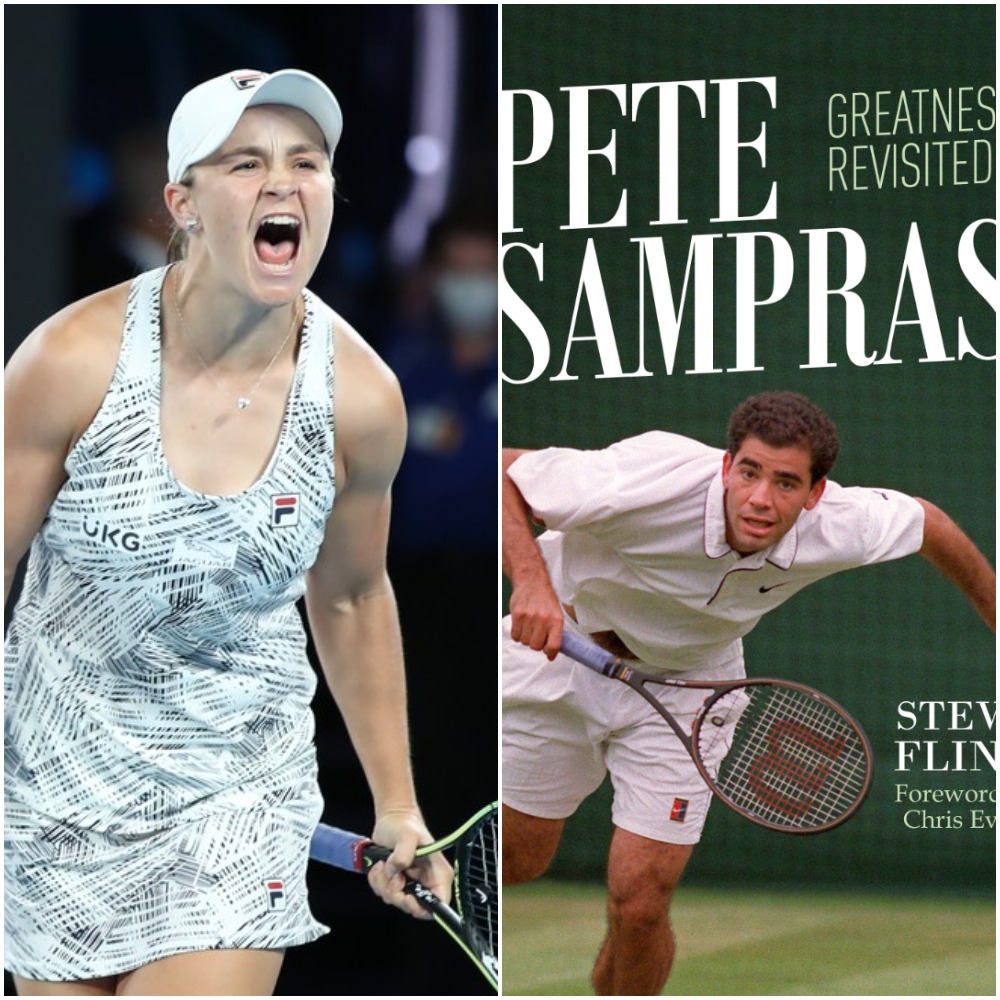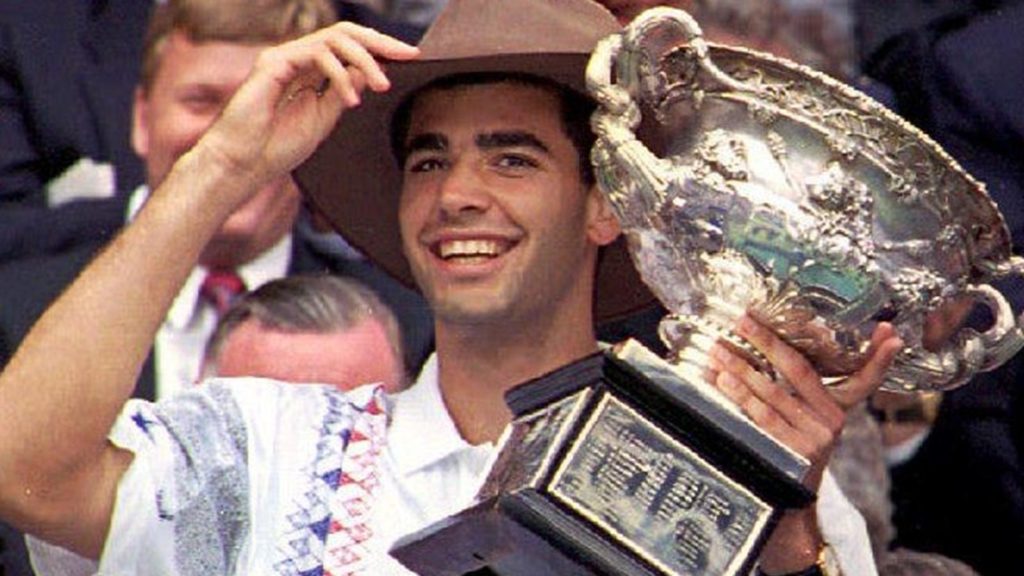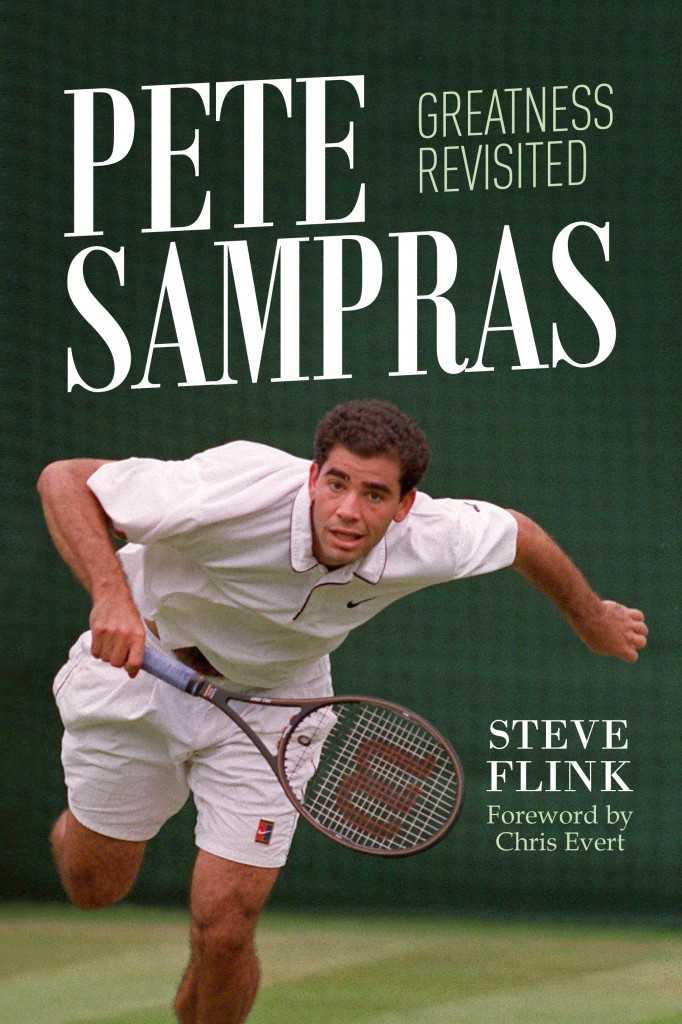In the pre Roger Federer, Rafael Nadal and Novak Djokovic era, Pete Sampras was regarded as perhaps the greatest tennis player of all time. His 14 major singles titles was thought to stand at least a test of some time, but was only the all-time men’s record for seven years. If it not for a breakthrough win at Wimbledon in 1993, Sampras, perhaps, may not have reached the heights that he attained.
In his book on Sampras called “Pete Sampras: Greatness Revisited,” Hall of Famer Steve Flink discusses that first of seven Wimbledon titles for Sampras and how it catapulted him to the greatness he achieved, when doubt lingered beforehand. An exclusive book excerpt can be read below.
Sampras had moved to 5-2, just one game away from winning his first Wimbledon. Courier held on in the eighth game and so Sampras had to serve it out in the ninth. The opening point was spectacularly played by both players, ending with a netted diving forehand volley from Sampras. Sampras garnered the following two points for 30-15 but the anxiety was crowding in on him now. He was hunched over, trying to stretch, wanting to end it all swiftly. A deep second serve drew a return error from Courier, and now Sampras was crouching again. He sent a second serve at 40-15 out wide to the forehand, sticking with a winning formula. But Courier laced a return down the line that Sampras could not handle on the half volley. At 40-30, Sampras made certain to get a first serve in down the middle and punched a backhand first volley crosscourt without overplaying it. The volley stayed low on the grass and Courier netted a backhand pass. Sampras raised his arms jubilantly. He had just won the most important tournament in all of tennis, overcoming the man who had finished the previous year as the No. 1 ranked player in the world, winning the final 7-6 (3), 7-6 (6), 3-6, 6-3. He had at long last collected a second major title, moving past his anxiety to reward himself handsomely with a hard earned triumph that would put him into a different sphere of the sport from that point forward.
Sampras spoke with clarity in 2019 about the deep inner tension he felt on that afternoon long ago. Talking about why he was hunched over at the end, he said, ‘It was nerves. It was the moment. It was exhaustion. It was the accumulation of two days of stress. There was no coach and no parent that was going to tell me something to get me through that. It was up to me. I was not feeling great but I really wanted to win.”
Courier felt he played awfully well. He said, “I couldn’t have played a better grass court match. I just ran into a player in Pete who was at a different level on that surface.”
Tom Gullikson spoke with Courier after the match. He said, “I remember speaking with Jim and I am a big stats guy. Sampras double faulted only four times in four sets and his average first serve speed was 119 mph and his average second serve speed was 109 mph. For the differential to be only ten mph is absurd. Not many players today can say they have a 10 mph differential between first and second serves. So when people talk about the Sampras serve, certainly he had one of the greatest first serves of all time. But Courier said to me, ‘How can I compete with a guy who has two first serves every point?’ I thought that was pretty funny, but true.”
Putting this triumph into historical perspective, Sampras emphasized, “That first Wimbledon win was a big turning point in my career. I had that big win at the Open in 1990 and then went through two years of doing fine, but not being willing to get dirty. In that match with Jim, I got dirty. I dug deeper maybe than ever to win. I played the next number of years with a lot of relief because of what that win meant.”
The significance was so large in Sampras’s mind that he felt in retrospect winning that first Wimbledon was of even higher value than taking the U.S. Open in 1990. He said in 2019, “Beating Jim to win Wimbledon was more important than my first Open. The first Open was great. It was wonderful. It was a fairytale. But this one at Wimbledon in ‘93 was more about, ‘Here I am and I am going to be around for a while. And I could very well dominate this sport for the next six or seven years.’ I felt that in my heart and I felt I was just more comfortable as a man, more comfortable in the limelight, more comfortable
being the best player in the world. It took me some time to get there, but everything just calmed down over the next six or seven years. That was a big one at Wimbledon.”
It clearly was. As Courier put it, “In hindsight, it certainly was a line of demarcation for both of us. If I win that one, maybe he has doubts and doesn’t go on to the success that he has and that gives me more opportunities. He shut me down on many an occasion at a major. Who knows? You never really know. But I didn’t go away from Wimbledon feeling like it was a failure of an event at all. I was certainly disappointed that I had come so close and I had lost that one as well as a close five-eset final in Paris, but I certainly liked the way I was playing. In many ways it was probably a more pivotal match for Pete than it was for me.”
That is surely the case. A loss there might have left a lasting mark on the Sampras psyche. He put an almost unbearable amount of pressure on himself to win that tournament, to fight uncompromisingly and find a path to victory. He had done just that. And he had upended in succession the defending champion Agassi, three-time former Wimbledon victor Becker and four-time major champion Courier. Knocking out that renowned ABC trio was a monumental achievement and a sweepingly impressive way to make a breakthrough on the lawns of the All England Club. He had captured his first major almost unconsciously, but in taking his second he was acutely aware of everything he was doing and what it all meant. Now Sampras was becoming what he always wanted to be. He was a different man made of tougher stock, obsessed with making the most of his potential, poised to take over tennis for some time to come.
For sale and download here via amazon.com: https://www.amazon.com/dp/1937559947/ref=cm_sw_r_tw_dp_x_UeesFbJQPME51 “Pete Sampras: Greatness Revisited” reviews the career and legacy of Sampras, who when he announced his retirement in 2003 was the most accomplished men’s tennis player of all time with a record 14 major singles titles. The Sampras career and legacy, however, became quickly overshadowed with the emergence of Roger Federer, Rafael Nadal and Novak Djokovic, all of whom surpassed the Sampras mark in a span of just over 16 years. Flink’s book, launched on the 30-year anniversary of the historic first major singles title for Sampras at the 1990 U.S. Open, re-examines the Sampras era and reminds readers of his dominance and excellence, focusing primarily on each major singles victory.
For the book, Flink extensively interviewed Sampras, who provided insight and perspective decades after his triumphs on the Grand Slam stages. The book also features perspectives and commentaries from Sampras rivals, coaches and tennis legends, including Novak Djokovic, Stefan Edberg, Goran Ivanisevic, Jim Courier, Patrick Rafter, Tom Gullikson, Martina Navratilova, Billie Jean King, Tracy Austin, Paul Annacone and Todd Martin among others.
“I felt compelled to write this book about a singularly commendable champion who set the highest ethical standards throughout a magnificent career,” said Flink. “Sampras was inspiring to me as a journalist who deeply valued his craftsmanship and authenticity— and immensely admired how he established himself as a quietly ferocious competitor and sportsman of the highest order.”
“Steve Flink is a tennis purist,” said Sampras in support of the book. “He followed my career as closely as any journalist. In this insightful biography, he shares his deep knowledge of tennis and writes with great clarity about me and how I approached my profession. Steve’s understanding of my game, my personality and my priorities is extraordinary.”
Six-time U.S. Open champion Chris Evert contributed the foreword to the book and wrote, “Steve is a great writer and historian and in this book he puts Pete’s career fully into perspective. I am sure you will enjoy reading this enlightening and comprehensive account about Pete Sampras, a very graceful champion and one of the greatest players any of us will ever see.”
Thirty years ago in 1990, at the age of 19 years and 28 days, Sampras became the youngest U.S. Open men’s singles champion with a 6-4, 6-3, 6-2 victory over Andre Agassi. Ten years later in 2000, Sampras won his record-breaking 13th major singles title, eclipsing the record for all-time men’s singles majors held by Roy Emerson, by beating Patrick Rafter 6–7 (10), 7–6 (5), 6–4, 6–2 in the Wimbledon final. Sampras put an exclamation point on his career at the 2002 U.S. Open when he defeatedAgassi 6–3, 6–4, 5–7, 6–4 to win his 14th career major singles title in a match that eventually became the final match of his career.
Flink is a tennis journalist and member of the International Tennis Hall of Fame who has covered more than 100 major tennis tournaments in his career. He is a columnist for TennisChannel and Tennis.com and also the author of the book “The Greatest Tennis Matches of All Time.” He is the former editor of World Tennis magazine and a former senior columnist at Tennis Week. He is a former varsity tennis player at Stetson University in Florida and now lives in Katonah, New York.
Founded in 1987, New Chapter Press (www.NewChapterMedia.com) is also the publisher of “Juan Martin del Potro: The Gentle Giant” by Sebastian Torok, “The Pros: The Forgotten Era of Tennis” by Peter Underwood, “The Greatest Tennis Matches of All-Time” by Steve Flink, “The Education of a Tennis Player” by Rod Laver with Bud Collins, “The Secrets of Spanish Tennis” by Chris Lewit, “The Bud Collins History of Tennis” by Bud Collins, “The Wimbledon Final That Never Was” by Sidney Wood, “Titanic: The Tennis Story” by Lindsay Gibbs, “Macci Magic: Extracting Greatness From Yourself And Others” by Rick Macci with Jim Martz, “Andy Murray, Wimbledon Champion: The Full Extraordinary Story” by Mark Hodgkinson, “Cattle To Courts: A History of Tennis In Texas” by Ken McAllister, “Sport of a Lifetime: Enduring Personal Stories From Tennis” by Judy Aydelott, “Trojan Tennis: A History of the Storied Men’s Tennis Program at the University of Southern California” by S. Mark Young, “Absolute Tennis: The Best And Next Way To Play The Game” by Marty Smith, “How To Permanently Erase Negative Self Talk So You Can Be Extraordinary” by Emily Filloramo, “Acing Depression: A Tennis Champion’s Toughest Match” by Cliff Richey and Hilaire Richey Kallendorf, “Your Playbook For Beating Depression: Essential Strategies For Managing and Living with Depression” by Cliff Richey and Mary Garrison, “Roger Federer: Quest for Perfection” by Rene Stauffer, “The Days of Roger Federer” by Randy Walker, “Jan Kodes: A Journey To Glory From Behind The Iron Curtain” by Jan Kodes with Peter Kolar, “Tennis Made Easy” by Kelly Gunterman, “On This Day In Tennis History” by Randy Walker, “A Player’s Guide To USTA League Tennis” by Tony Serksnis, “Court Confidential: Inside The World Of Tennis” by Neil Harman, “A Backhanded Gift” by Marshall Jon Fisher, “Boycott: Stolen Dreams of the 1980 Moscow Olympic Games” by Tom Caraccioli and Jerry Caraccioli (www.Boycott1980.com), “Internet Dating 101: It’s Complicated, But It Doesn’t Have To Be” by Laura Schreffler, “How To Sell Your Screenplay” by Carl Sautter, “Bone Appetit: Gourmet Cooking For Your Dog” by Suzan Anson, “The Rules of Neighborhood Poker According to Hoyle” by Stewart Wolpin among others.




